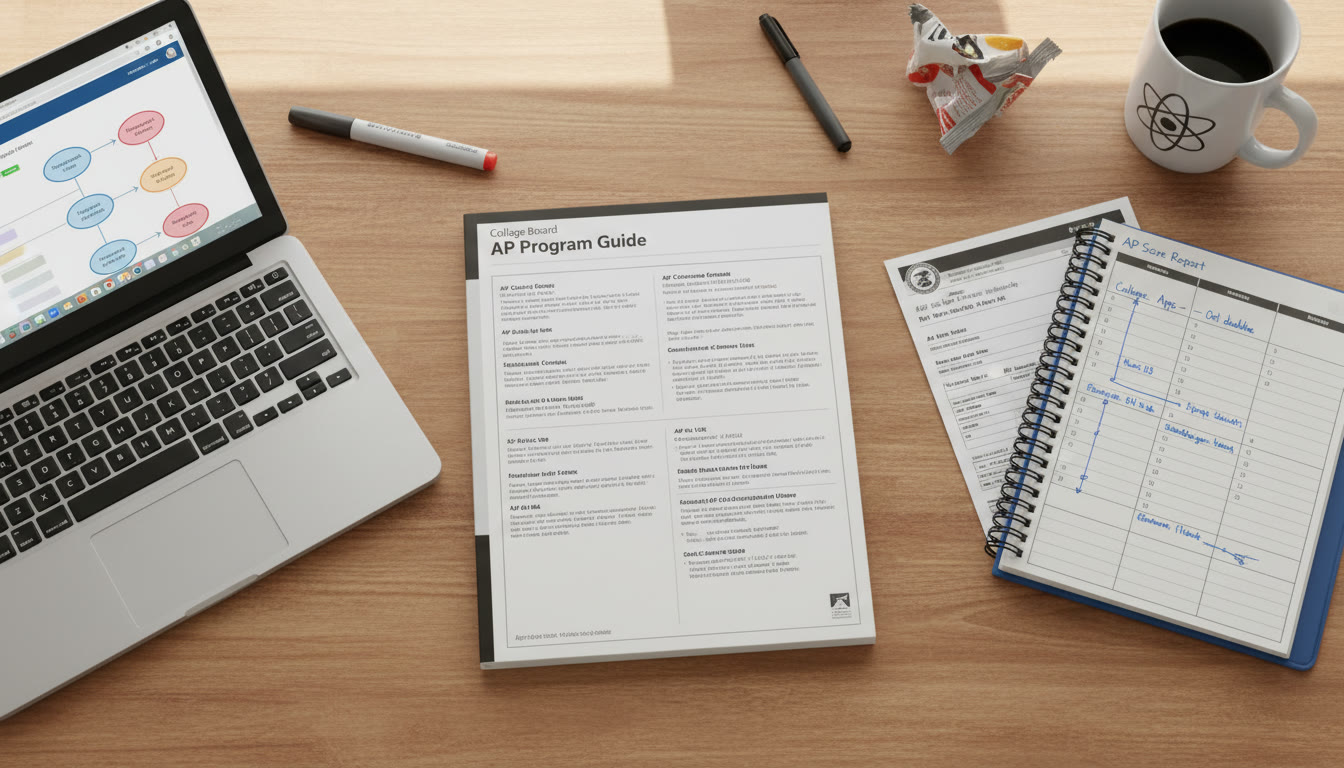Why this matters: AP scores and combined-degree dreams
So you scored an AP 5 on Chemistry or Calculus BC — congratulations. That flash of possibility is natural: could those scores shave time off a combined program, move you into upper-level classes faster, or even help make a very expensive degree cheaper? For students aiming at combined programs like BS/MD (direct medical programs), 3+2 engineering arrangements, or 4+1 master’s pathways, AP credit sometimes plays a starring role — but more often it’s a supporting actor with a complicated script.

The good news — what AP does well
AP exams show college readiness and can deliver three practical benefits when you’re in a combined program track:
- Placement advantage: AP scores often let you start in higher-level courses (for example, placing into Calculus II or general chemistry lab sequences), which can free up your schedule for major-specific classes earlier.
- Potential credit: Some schools award credit (semester hours or course equivalency) for certain AP scores, which might reduce the number of on-campus courses you must complete.
- Admissions signal: Strong AP coursework and scores strengthen your application for competitive combined programs; they demonstrate rigor, discipline, and readiness.
The reality check — limits and traps
But before you imagine skipping an entire freshman year, pause. Many combined programs are intentionally structured with fixed sequences, especially programs that guarantee professional school entry (like many BS/MD tracks) or that depend on tight accreditation requirements (certain engineering or nursing pathways). In short, AP credit rarely translates into an automatic shortcut to the professional component.
- Curriculum locks: Professional programs (medicine, engineering accreditation pathways) often require completion of core, sequential courses taken at the host institution. Those courses can be prerequisites for later accredited coursework and clinical experiences, and AP credit may not replace them.
- Variable credit policies: Every institution sets its own AP credit and placement rules — and those rules can differ within the same university by school or college. Your university’s College of Arts & Sciences might accept an AP score for credit, while the School of Engineering or the medical program expects you to take their in-house sequence.
- Time-to-degree expectations: Combined programs are choreographed. For example, a 3+2 program expects you to spend three years at one campus and two at another. Even if you arrive with credits, program milestones, transfer rules, or professional-school prerequisites often keep you on the original timeline.
How to read the fine print — a step-by-step plan
Understanding how your AP results may (or may not) help requires careful reading and some conversations. Follow these pragmatic steps to avoid surprises:
1. Start with the program handbook and the registrar
Combined programs almost always publish policies in a program handbook or on the registrar’s page. Look for sections titled “AP Credit,” “Advanced Standing,” or “Transfer Credit.” If you can’t find clarity there, email the registrar and the program coordinator — ask precise questions, not general ones.
2. Ask the right questions
- Does the program accept AP scores for credit or only for placement?
- Which AP exams and score thresholds are accepted (for example, do they require a 4 or a 5)?
- Will AP credit count toward major requirements, general education, electives, or only as free elective credit?
- Are there internal program rules that require courses to be completed at the host institution regardless of AP credit?
- If credit is granted, how will that affect financial aid, scholarship renewal, or program eligibility?
3. Map your academic timeline twice
Create two roadmaps: one assuming AP credits are applied, one assuming they are not. Put everything on the calendar — prerequisite deadlines, clinical or capstone years, required internships, and licensing-related timelines. This is your best hedge against unpredictable policies.
Common scenarios and realistic outcomes
Below are typical ways AP credit is handled in combined programs, and what that means for you.
Scenario A: AP for placement only
Many programs allow AP to place you into higher-level classes but will still require you to take certain foundational courses at the institution. Example: AP Calculus BC lets you start in Multivariable Calculus, but the school still requires their version of Calculus I content embedded in an engineering freshman seminar — so you can’t skip the campus experience.
Scenario B: AP for elective or gen-ed credit, not major core
Here AP reduces your total credit load but doesn’t cut into required major courses. That can free up a semester for a research internship, a study-abroad window, or lighter course loads during intense professional years — a big practical win.
Scenario C: AP converts to direct major/course credit
Less common but powerful: AP awards course equivalency (for example, AP Chemistry = Introductory Chemistry I). If the combined program accepts equivalency, you may be able to begin higher-level major requirements sooner — but verify that the equivalency satisfies any accreditation or downstream prerequisite rules.
Table: Typical AP Score Outcomes by Program Type
| Program Type | Most Likely AP Outcome | What It Really Buys You |
|---|---|---|
| BS/MD (Direct Medical) | Placement; limited elective credit | Frees up electives or lightens first-year schedule; rarely shortens guaranteed timeline |
| 3+2 Engineering | Placement; general credit accepted variably | Can smooth the transition to the 2nd school; rarely reduces the required 5-year structure |
| 4+1 Master’s | Possible reduction of undergrad electives; sometimes allows earlier start on grad prerequisites | May let you take graduate electives earlier or finish accelerated master’s coursework faster |
Important practical details families often miss
AP credit and scholarship or financial aid rules
Some scholarships tie disbursement or renewal to credit loads or enrollment in certain courses. If AP credit reduces your enrolled credits below a threshold, it could unintentionally affect aid. Always check financial aid rules before accepting credit.
Accreditation and licensing considerations
Fields that lead to licensure (engineering, nursing, some health professions) often require coursework completed at an accredited institution in a specified sequence. Even if you have AP credit, you may still need to take particular on-campus classes to satisfy accreditation standards.
Transferability between partner institutions
In 3+2 and some 4+1 programs, two institutions coordinate curricula. One partner may accept AP credit differently than the other; when you move to the second campus, credits that were accepted initially could be re-evaluated. Confirm the partner-school policy early.
How to approach admissions and course planning
Admissions: Use AP to show readiness, not to promise shortcuts
On an application, AP coursework and scores are evidence of academic ambition and preparation. For selective combined programs, highlight APs strategically: show competency in science/math for medical or engineering tracks, and write about how AP experiences taught study habits and problem-solving skills. But don’t tell admissions you expect to skip core program years based solely on APs — that’s a future administrative conversation, not an admissions guarantee.
Course planning: Be flexible and opportunistic
If AP gives you placement into higher-level courses, lean into opportunities that those openings create: take a research methods class, start undergraduate research early, pick up a minor, or explore interdisciplinary electives. These experiences often matter more for graduate and residency applications than shaving a semester off your degree.
Real-world example: A plausible pathway
Imagine Lina, a student accepted into a BS/MD program who arrives with AP scores in Biology (5), Chemistry (4), and Calculus BC (5). The program allows her to place out of introductory biology and calculus but requires its own chemistry lecture-and-lab sequence for the medical track.
- Outcome: Lina uses calculus placement to take Biostatistics in year one instead of repeating Calculus II, freeing one semester to take a research practicum.
- Benefit: The early research practicum becomes a distinguishing part of her CV when she applies for competitive summer research and later strengthens her medical school readiness.
- Caveat: Her AP Chemistry did not translate to credit toward the program’s chemistry requirement, so she still completed the required on-campus chemistry labs in year one.
Takeaway:
AP increased Lina’s flexibility and enriched her undergraduate experience, without changing the formal timeline of the combined program. That tradeoff — depth of experience over pure time saved — is common and often the most valuable.
Checklist: What to do after you get your AP scores
- Keep an official copy of your AP score report and request that it be sent to the college registrar when required.
- Cross-reference the university’s published AP credit chart with the combined program handbook.
- Email both the registrar and the program coordinator with specific questions about credit, placement, and program prerequisites.
- Map two academic timelines (with and without AP credit) and discuss them with your high school counselor, parent, or Sparkl’s admissions/tutoring advisor.
- Consider whether earlier upper-level coursework or freed-up semesters could be devoted to research, internships, or a meaningful minor.
When to accept AP credit — and when to decline it
On some campuses you are asked to accept or decline credit after matriculation. A few strategic rules-of-thumb:
- Accept credit if it clearly reduces wasted duplication of learning and does not impact program eligibility or scholarship rules.
- Consider declining credit if accepting it would place you in a course sequence that leaves gaps or eliminates a prerequisite that you prefer to learn on campus.
- Decline or delay acceptance if you want to preserve options — for example, keeping core classes on your transcript that graduate programs or medical residencies regard as important.
How Sparkl can help (where it fits)
Families often benefit from personalized guidance through this maze. Sparkl’s personalized tutoring can help in several practical ways: 1-on-1 guidance to select AP subjects strategically, tailored study plans to maximize AP scores, expert tutors who help you demonstrate readiness in essays and interviews, and AI-driven insights that highlight which AP results are most likely to yield value at specific programs. Those services are especially helpful when you must make nuanced choices — like whether to accept credit or use AP for placement only.
Frequently asked questions — quick answers
Will AP credit let me graduate faster from a 3+2 or BS/MD?
Rarely. Combined programs are built around fixed sequences. While AP may reduce elective load or move you into higher-level courses, most program milestones (clinical rotations, accreditation requirements, partner-school residency) preserve the timeline.
Do all AP 5s count the same at every school?
No. Which score (4 or 5) translates to credit and which courses are credited differs by institution and sometimes by department.
If I don’t accept AP credit now, can I accept it later?
Policies vary. On many campuses you can apply for credit within a time window post-matriculation, but program rules may restrict retroactive crediting. Ask early and get answers in writing.
Final thoughts: Aim for advantage, not entitlement
AP excellence opens doors — it validates your readiness and can create meaningful flexibility. But combined programs are engineered to shape professional development, not simply compress calendar time. The smartest strategy is to view AP results as leverage for deeper experiences (undergraduate research, meaningful internships, early exposure to professional mentors) rather than as a guaranteed fast-forward button.
Talk to program coordinators, verify registrar policies, model multiple academic timelines, and use your freed-up academic space wisely. When you pair strong AP performance with intentional choices — shepherded by good advising or tailored support like Sparkl’s tutors and planners — you turn a score into momentum that counts where it matters most: depth of preparation, not only the speed of the journey.

Resources to keep handy
Before you sign any acceptance of credit or placement decision, keep these items available for your conversations with advisors:
- Your official AP score report
- The combined program handbook or articulation agreement
- The university’s AP credit chart and registrar policy
- Financial aid/scholarship terms and any stipulations about minimum credit loads
- Notes from conversations with program coordinators, ideally in writing
Parting advice for students and parents
Be proud of strong AP results — they are evidence of your commitment and ability. But pair that pride with curiosity and due diligence. The fine print matters: semesters, accreditation, scholarships, and program-specific rules can all change the value of an AP score. Approach each decision as an opportunity to design a richer undergraduate experience — not merely as a way to accelerate the clock.
Finally, when the roadmap gets confusing, ask for help. Sparkl’s personalized approach — combining experienced tutors, tailored study plans, and data-driven insights — can turn uncertainty into a clear plan of action. With the right information and a flexible mindset, AP scores become not just transcripts line items, but stepping stones for meaningful learning and long-term success.




















No Comments
Leave a comment Cancel